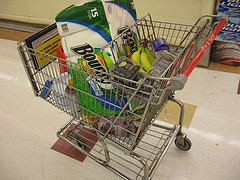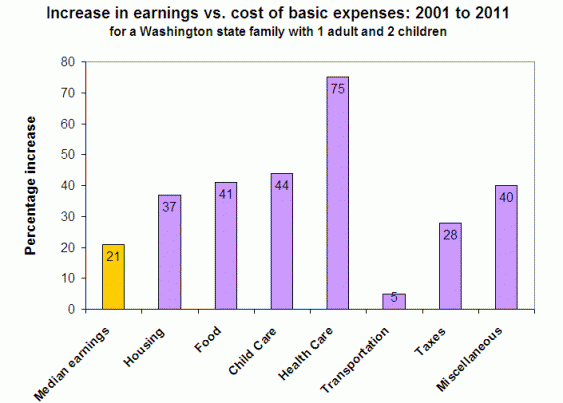What does it take to live in Washington state? To pay for the bare necessities like rent, childcare, groceries, clothing, shoes, transport to work, telephone service, cleaning products and household items? (That’s without the additional costs of any comforts such as savings, vacations, cable TV, or the occasional restaurant meal.)
A new report and this handy online calculator from the University of Washington School of Social Work researcher Diana Pearce answers that question in great detail. She’s come up with a “self-sufficiency wage” for families of various sizes and compositions living in each of the state’s counties.
A single adult with one preschooler and one school-age child in Seattle, for instance, needs to earn $56,904. In the Eastside suburbs, it’s $65,690. In Adams County, it’s $34,074. In Thurston County, it’s $46,922. Because actual wages also vary by geography, these differences don’t necessarily mean it’s easier to raise your kids in Yakima than Bellevue. But the self-sufficiency wage gives people in a particular location an idea of what a true living wage would be.
The report is full of interesting data that demonstrate how little the federal definition of poverty has to do with surviving in the real world. They also help explain why so many people feel economically squeezed and why year after year it feels harder to make the same ends meet. In the last two years, for instance, the recession has kept median income from growing across Washington state. But the economic downturn hasn’t kept the cost of basic needs from rising. Over that time period, the cost of food and housing and other life expenses across Washington state rose by 8.4 percent, the report found.
The chart below also shows how much the basic cost of living has outpaced income for that same 3-person Washington family over the last decade. Median earnings grew by 21 percent, while the cost of housing, childcare and food have risen roughly twice that much. Health care premiums and out-of-pocket costs have grown by 75 percent. (One caveat: I couldn’t find a good explanation in the report of why transportation costs have risen so little, which seems curious given that gas prices roughly tripled and transit fares increased in many locations during that time.)
Here are some other takeaways from the report:
Kids cost a lot
As the mom of a 3-year-old, I found this chart both terrifying and reassuring. The childcare costs for infants and preschool children can throw a family’s budget dramatically out of whack. The good news is that those expenses come back down to earth once they get into elementary school. Until your food costs rise when your teenagers start raiding your fridge.
 (For a larger version of this chart, click here.)
(For a larger version of this chart, click here.)
Your taxes aren’t the problem
Over the last decade, taxes for that average 3-person Washington family have risen by 28 percent. Compare that to the cost of housing (up 37 percent), food (up 41 percent), childcare (up 44 percent), health care (up 75 percent) and other necessities like clothing, shoes, telephone service, and household goods (up 40 percent). Additionally, the value of tax credits available to this type of family rose substantially over that time period.
Many common professions don’t pay a living wage
In Thurston County, an adult with one preschooler and one school-age child would need to make $22.22 an hour to meet the self-sufficiency standard. Of the 10 most common professions in Washington state, only registered nurses earn that much, making $36.25 an hour. The other large professions—retail salespeople, cashiers, food prep and servers, office and stock clerks, bookkeeping and accounting clerks, laborers, and janitors—earn between $9 and $18 an hour.
Social service programs are essential
Many social service programs are on the chopping block right now. But the supports available to lower-wage earners, including childcare and housing assistance, food stamp programs and kids’ health care coverage, are the only way many working parents can adequately meet their families’ basic needs in Washington. That’s the reality right now, if not the ideal situation, as the report concludes:
True longterm self-sufficiency means the ability of families to meet basic needs without any public or private assistance. Fully closing Washington’s wage gap will require increasing the skills of low-wage workers, recognizing the importance of asset building, and public policies that make work pay.
The report is worth a look for anyone wrestling with budget issues—either on a public scale or at their own kitchen table.










Linda Kunicki
I’d like to see how this same scenerio would play out in the suburbs of Chicago, IL
Diana M Pearce
Linda – Check the Self-Sufficiency Standard website – under Publications you will see a map; click on Illinois, and it will take you to the Illinois data and reports, and you can answer your question about the Chicago suburbs, with data comparable to Seattle’s (same methods, sources, etc.) Email us if you have any questions…